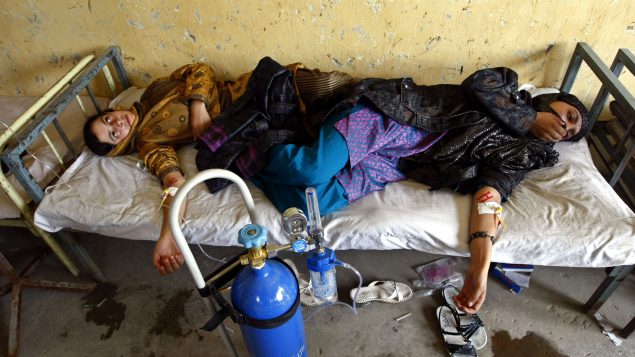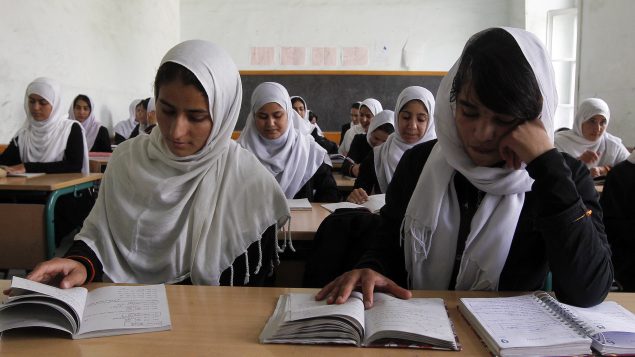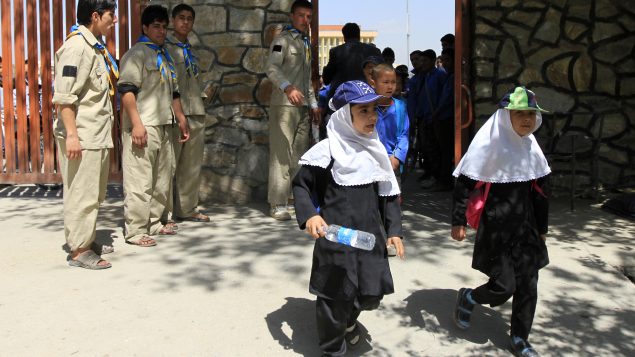A global coalition of NGOs working to advance education of children in conflict zones says recent gains in expanding access to education that have allowed millions of Afghan boys and girls to enroll in school are at risk due to growing attacks on students, teachers, and schools.
The numbers of children, particularly girls, who are out of school in Afghanistan are once again rising, according to a report by the Global Coalition to Protect Education from Attack.
The report entitled Attacks on Education in Afghanistan was released Tuesday to coincide with the Geneva Ministerial Conference on Afghanistan, taking place on Nov. 27 and 28.
“Right now we’re looking at 3.7 million children out of school in Afghanistan, which is a level we haven’t seen since 2002,” said Annie Bodmer-Roy, head of Policy, Advocacy and Campaigns at Save the Children Canada.
Girls make up about 60 per cent of this number or about 2.2 million, Bodmer-Roy said.
“And this increases even more in insecure areas,” said Bodmer-Roy in a phone interview from Ottawa. “So really we’re looking at a country that in general has a lot of security issues but in particular there are insecure areas in places like Kandahar or Uruzgan, where up to 85 per cent of girls are missing out on education.”
ListenThe Afghan Ministry of Education and international agencies have identified social and cultural attitudes, child marriage, poverty, violence and bullying, lack of educational infrastructure, overcrowding, chronic teacher shortages, and insecurity, as some of the key factors preventing children from going to school, the report says.But attacks on schools, students and teachers and the military use of schools is the biggest factor of all, Bodmer-Roy said.
Just in the first half of 2018 there have been more attacks on education than in the whole of 2017, she said.
“In fact it’s double what we saw in 2017,” Bodmer-Roy said. “And that just the attacks that we can verify, we think that in reality the number is much higher.”
Attacks increasingly target girls

Afghan school girls receive treatment at a hospital after being poisoned in Kabul August 28, 2010. Seven Afghan school girls were taken to hospital after a suspected gas poisoning attack on their school in the east of Kabul, said Education Ministry official Asif Nang. (Omar Sobhani/REUTERS)
While the attacks on schools in 2018 might have spiked because of the widespread use of schools as polling stations during the recent Afghan elections, there is a growing trend of targeting educational facilities in Afghanistan.
“Over the past six years, the Global Coalition to Protect Education from Attack has seen a growing proportion of attacks on education in Afghanistan that have targeted girls,” Bodmer-Roy said. “So attacking, for example, girls’ schools, or girls on their way to and from schools, attacking female teachers who are more likely to be educating girls, this is a very significant area of concern for us.”
In conflict or crisis areas worldwide girls are 2.5 times are more likely to be out of school than boys, she said.
“We know that when we educate girls, they are more likely to get a job, to contribute to their communities, they are more likely to put their children through school in the future, and they are more likely to be protected from things like sexual violence in a conflict,” Bodmer-Roy said. “Education in itself is important and it is a right but it is also very protective and it helps to keep children safe.”
Funding education for girls

British Prime Minister Theresa May, German Chancellor Angela Merkel, Canada’s Prime Minister Justin Trudeau, France’s President Emmanuel Macron and Japanese Prime Minister Shinzo Abe wait for U.S. President Donald Trump to join them for a family photo at the G7 Summit in Charlevoix, Quebec, Canada, June 8, 2018. (Leah Millis/REUTERS)
There are a lot of ways Canada can support girls’ education in Afghanistan, Bodmer-Roy said.
“In fact, we have seen earlier this year Canada demonstrate significant leadership at the G7,” Bodmer-Roy said.
At the G7 Leaders’ Summit in June, Prime Minister Justin Trudeau rallied leaders to commit to the G7 Charlevoix Declaration on Quality Education for Girls, Adolescent Girls and Women in Developing Countries.
The declaration includes a number of commitments to ensure that even in crisis or conflict settings girls continue to have access to education and that access is safe and free from harassment, Bodmer-Roy said.
In addition to this policy commitment, Minister for International Development Marie-Claude Bibeau announced $3.8 billion in funding pledges from the Canada, the EU, Germany, Japan, the U.K. and the World Bank to support girls’ education in crisis and conflict, Bodmer-Roy said.
Canada contributed $400 million to this initiative.
This represented the single largest investment in education for girls in crisis and conflict settings, Bodmer-Roy said.
“Really what we’re looking for now is to ensure that when that funding is implemented, that we’re looking at contexts like Afghanistan but also Somalia, South Sudan, Yemen, the Congo, Nigeria to ensure that girls in particular have access to schools and that access is safe,” Bodmer-Roy said.
Canada should also reserve some of its funding for international organizations that are working with national governments to endorse the safe schools declaration, she said.
Canada can also play a very important role in helping to set up robust monitoring of attacks on education, Bodmer-Roy added.
A Canadian priority

Girls study in a school in Kabul August 28, 2011. (Omar Sobhani/REUTERS)
Ensuring safe access to education for girls and boys is a key priority of Canada’s international assistance program in Afghanistan, said Global Affairs Canada spokesperson Maegan Graveline.
In July 2016, Canada renewed its commitment to Afghanistan’s development through $465 million in new security support and development assistance to Afghanistan up to fiscal year 2020-21, she said.
Since 2001, Canada has contributed a total of $285 million in education support to Afghanistan. This includes $50 million since 2016.
“In 2001, less than one million children, mostly boys, were enrolled in school in Afghanistan,” Graveline said. “Since 2006, Canada has established more than 9,200 community-based schools in rural and remote areas of Afghanistan to increase girls’ access to education.”
Over 80 per cent of the 273,000 students in those schools are girls. The Afghan Ministry of Education’s reports state that there are now more than 8.9 million students enrolled (in formal and community-based schools) and 3.4 million are girls, Graveline said.
“Canada is confident that our contributions to increasing access to education for girls in Afghanistan have helped to create a generation of girls and boys that are better prepared to create positive changes in their own lives and in the lives of their communities,” Graveline said.







For reasons beyond our control, and for an undetermined period of time, our comment section is now closed. However, our social networks remain open to your contributions.